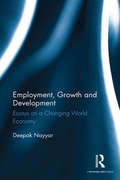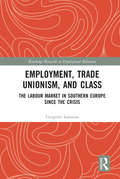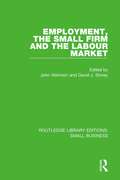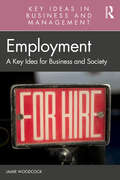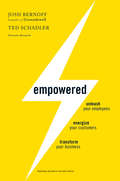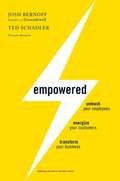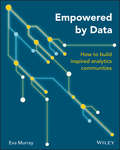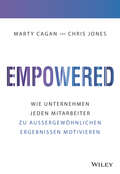- Table View
- List View
Employment at Will: A Legal Perspective
by Christopher M. Bruner Lynn Sharp PaineProvides a brief overview of the employment-at-will doctrine, an important concept unique to the U.S. legal system and business landscape. Briefly surveys the history and development of this doctrine and certain limitations and exceptions to it, as well as some of the distinguishing features of the employment termination process in the United States relative to other countries.
Employment in Community Psychology: The Diversity of Opportunity
by Joseph R Ferrari Clifford R O'DonnellDiscover the first book on employment opportunities in community psychology!Employment in Community Psychology: The Diversity of Opportunity is the first psychology career reference book for undergraduate psychology majors deciding on graduate schools, for graduate students in psychology seeking employment, and for psychology faculty advising their students. This book answers the questions “What can you do with a graduate degree in community psychology?” and “Who employs community psychologists?” Employment in Community Psychology addresses these questions through examples of graduates educated in community psychology and employed in diverse applied, research, and academic settings. In Employment in Community Psychology, you will explore the diversity of community psychology employment opportunities through the stories of current graduate students, community psychologists on their first job, and psychologists who have well-established positions in community research and action. Each experience is told in a story-telling style allowing the reader to grasp a deeper understanding of the employment opportunities that cannot be obtained through abstract description alone. Some of the experiences that highlight opportunities in the field include:working in the Institute for Families in Society at the University of South Carolina as a Research Associate working as a researcher at the Korea Institute of Social Psychiatry to determine how primary prevention and action research can be applied to the promotion of adolescent mental health in Korean society doctoral studies that developed into the first community psychology position focusing on the issues of social justice and reconciliation between Indigenous and non-Indigenous groups in Australian town non-traditional academic positions in psychology working as a social worker for Native non-profit health corporation in Alaska a policy-oriented community psychologist, or a c.p. in the disabilities field entering a second career in community psychology at mid-lifeEmployment in Community Psychology is an essential tool for undergrads and graduate students considering a career in community psychology. The rich palette of community psychology experiences that are laid out for the career researcher and advisor are sure to assist students in deciding what area of community psychology they would like to pursue.
Employment in Crisis: The Path to Better Jobs in a Post-COVID-19 Latin America (World Bank Latin American and Caribbean Studies)
by Joana Silva Robertson Truman Packard Liliana SousaA region known for its volatility, Latin America and the Caribbean (LAC) has suffered severe economic and social setbacks from crises—including the COVID-19 pandemic. These crises have taken their toll on careers, wage growth, and productivity. Employment in Crisis: The Path to Better Jobs in a Post-COVID-19 Latin America provides new evidence on the effects of crises on the region’s workers and firms and suggests several policy responses that can bolster long-term and inclusive economic growth. This report has three key findings. First, crises lead to persistent employment losses and accelerate structural changes away from the formal sector. This change occurs more through reductions in the creation of formal jobs than through job destruction. Second, some workers recover from crises, while others are permanently scarred by them. Low-skilled workers can suffer up to a decade of lower earnings caused by crises, while high-skilled workers rebound fast, exacerbating the LAC region’s high level of inequality. Formal workers suffer smaller employment and wage losses in localities with higher rates of informality. And the reduced job flows caused by crises decrease welfare, but workers in localities with more job opportunities, whether formal or informal, bounce back better. Third, crises’ cleansing effects can increase efficiency and productivity, but these effects are dampened by the LAC region’s less competitive market structure. Rather than becoming more agile and productive during economic downturns, protected sectors and firms gain market share and crowd out others, trapping valuable resources. This report proposes a three-pronged mix of policies to improve the LAC region’s responses to crises: •Create a more stable macroeconomic environment to smooth the impacts of crises, including automatic stabilizers such as unemployment insurance and short-term compensation programs; •Increase the capacity of social protection and labor programs to respond to crises and coalesce these programs into systems that complement income support with reemployment assistance and reskilling opportunities; and •Tackle structural issues, including the lack of product market competition and the spatial dimension behind poor labor market adjustment—a “good jobs and good firms†? agenda.
Employment in the Informal Sector in India (India Studies in Business and Economics)
by Ishita MukhopadhyayThis book examines the transition, transformation and future of the informal sector, informal work and informal workers in India from the perspectives of development economics as well as those of international organisations.Though the informal sector has a long tradition in India, it has been transformed in the wake of neoliberal economic policy. The sector took on new prominence in the 1980s, and has since grown much stronger and established itself as the country’s dominant sector. Several reports on the informal sector appeared during this period, and the status of the sector in India is positioned in the context of this international scenario.The major debate concerns the definition of this sector. While international labour statisticians had suggested a mechanism of definition and measurement of the sector, Indian official statistics took a different approach. The book analytically elaborates the different definitions and measurement controversies in different countries and contextualises the official Indian position. While deliberating on the size, contribution, productivity, and potential of the informal sector, the heterogeneity and decomposition of the sector with respect to these aspects are also suggested. The book develops a political economic interpretation of the historical transition of the informal sector in India, employing heterodox economics as a theoretical basis, with a critical note on standard neoclassical economic analysis. The final part of the book focuses on understanding the development of capitalism in the country under neoliberalism, as that development is crucial to understanding the informal sector in any country, and particularly in India. In the current context, the volume will be of great relevance to researchers, non-government organizations, policy makers and international organisations working on the topic.
Employment of Persons with Autism: A Scoping Review (SpringerBriefs in Psychology)
by Emma Goodall Matthew BennettThis scoping review furnishes the reader with a contemporary overview of research about employment conditions related to persons on the autism spectrum. In this book six guiding questions are used to address various aspects of employment for persons on the autism spectrum, including job opportunities, removing barriers to employment, becoming successful at work, and management issues for employers working with people on the autism spectrum. The contents of this scoping review can appeal to many different readers. Persons on the autism spectrum can learn about proven strategies that they can use to maximise their success in the workplace. Employers, tertiary students, and lay people can learn methods that they can use to help employees on the autism spectrum obtain and maintain employment. Finally, researchers can learn about the current limitations of our knowledge about the autism spectrum and employment.
Employment without Inflation
by Benjamin HigginsThe world economy has undergone a fundamental transformation in recent decades and theoretical structures inherited from the 1930s through the 1950s, while retaining large elements of truth, are inadequate to deal with current problems. Benjamin Higgins feels that for a society such as the United States a fiscal policy needs to be adopted that can deal simultaneously with existing unemployment and inflation. He suggests three possible governmental policies: stimulating a high rate of long-run growth, by use of reward innovations and by maintaining the highest possible level of scientific and technical activity; isolating regions that are generators of inflation and others that are pools for unemployment; and establishing a system of direct controls similar to those used in wartime. Higgins describes the transformation of the cogent prewar business cycle, with its alternations of inflation or unemployment, then a transitional period of underemployment equilibrium and secular stagnation, and finally, the strange new world of today, one with economic fluctuations in the form of shifting trade-off curves and loops. He then applies his new paradigm to current problems, showing why they cannot be managed through macroeconomic monetary and fiscal policy. Higgins offers case studies of efforts to fight inflation and unemployment, and to reduce regional gaps, to show their strengths and weaknesses. It can be said that unemployment always results from too many people chasing too few jobs, and inflation is always caused by too much money chasing too few goods and services. Beyond such banal generalizations, Higgins maintains there is no single cause for either unemployment or inflation, and thus no single cure can be prescribed for either, let alone for both at once. Nor is it to be expected that the appropriate cure will prove to be the same in all countries at all times. He suggests that an optimal blend of monetary and fiscal policy that will produce the "minimum discomfort" is a good start. Employment Without Inflation will be of direct policy interest to economists, sociologists, and national planners.
Employment, Growth and Development: Essays on a Changing World Economy
by Deepak NayyarThis book examines the critical themes of employment, growth and development to focus on challenges and opportunities, both old and new, in the contemporary world economy. The essential theme that runs through the book is that there is a strong relationship not only between employment and growth, but also between employment and development, where the causation runs in both directions. The author shows how employment transforms economic growth into meaningful development by providing livelihoods and incomes to people. While the book is primarily concerned with developing countries, it considers industrialized countries as points of reference or comparison, since the latter are a large part of an interdependent world, in which problems faced by the two sets of countries are frequently connected and sometimes common. The ten essays in this volume also provide a macroeconomic analysis of development problems situated in the wider context of a changing world economy, exploring possible solutions, to understand the implications for countries and for people. A timely collection by an eminent economist, this book will be useful to teachers, students and researchers in economics, especially those interested in macroeconomics, political economy and development studies.
Employment, Income Distribution and Development
by Frances StewartFirst Published in 1975. Routledge is an imprint of Taylor & Francis, an informa company.
Employment, Retirement and Lifestyle in Aging East Asia (Social Policy and Development Studies in East Asia)
by Xinxin MaThis project offers a comprehensive look at aging policies across East Asia, where a demographic dividend fuelled rapid growth and is now aging into a lower-speed economy. With a comprehensive look at numerous East Asian societies, including China, Japan, Korea, and other regions, the book is rich in comparative insights and strategies into what is effective for policymakers and employers. As the Asian century begins, this book will be an invaluable resource for economists, policymakers and demographers.
Employment, Trade Unionism, and Class: The Labour Market in Southern Europe since the Crisis (Routledge Research in Employment Relations)
by Gregoris IoannouThe economic crisis has brought about a watershed in institutional, political, and social relations, reshaping the labour market and the class structure in southern Europe. This book provides a critical comparative assessment of the dynamics of change in the employment field, focusing on Spain, Greece, and Cyprus. The book assesses how the liberalization and deregulation processes and the promotion of market-enhancing reforms progressed in three different national settings, identifying the forces, agents, contexts, and mechanisms shaping the employment and industrial relations systems. The comparative perspective used deciphers the interplay of external and internal dynamics in the restructuring of the labour field in Southern Europe, examining austerity and its contestation in connection with prevailing societal ideologies and class shifts. The first part of the book sets the theoretical and historical context, the second is comprised of three empirical national case studies, and the third discusses comparatively the handling of the crisis, its impact, and its legacy from the standpoint of a decade later. The book presents differences in industrial relations systems, trade union forms, and class composition dynamics, accounting for the development of the crisis and the reshaping of the employment field after one decade of crisis. It will be of value to researchers, academics, professionals, and students working on issues of employment and industrial relations, labour market and labour law, political economy and class structure, as well as those interested in the contemporary society and economy of southern Europe in general, and Spain, Greece, and Cyprus in particular.
Employment, Training and Lifelong Learning: Comparative Perspectives (Routledge Research in Employment Relations)
by Lourdes Mella Méndez Silvia Fernández Martínez Bárbara Torres GarcíaThis book offers a timely exploration of the continuous training of individuals, a subject crucial to both business competitiveness and societal progress in today’s rapidly changing world. Addressing the digital and climate revolutions, it examines how lifelong learning helps workers adapt their skills to meet evolving demands while supporting active ageing for all citizens, even in retirement.Divided into three sections, the book features studies that combine theoretical insights and practical recommendations from renowned experts in education and law. The book stands out for its international scope, with chapters covering diverse national perspectives from countries such as the United Kingdom, the United States, Japan and various European nations. It uniquely integrates both education and legal perspectives, providing a comprehensive analysis that addresses gaps in existing literature. Readers will benefit from clear, accessible language, proposals for key stakeholders (e.g., policymakers, social partners), and coverage of pressing issues like vocational training for immigrants, legal frameworks for non-formal learning and the impact of digital transitions on workforce development.This book is an essential resource for academics, researchers, advanced students, legal professionals, educators, policymakers, trade unions, and employer associations. It offers valuable insights for anyone involved in Labour Law, social security, vocational training or workforce development on a global scale.
Employment, Wages and Income Distribution: Critical essays in Economics
by Kurt W RothschildWhilst there is widespread agreement about the goals of economic policy, consensus about how best to achieve them can be harder to achieve. No issues are more contentious than employment and income distribution. In recent years full employment and a just distribution of incomes have been downgraded as policy objectives, as greater priority has been given to price stability and balance of payments objectives. This emphasis has been supported by a mainstream economic theory which has an unswerving belief in the ability of market forces to achieve a satisfactory regulation of employment and income distribution Other economists have remained more sceptical, and none more so than Kurt Rothschild. This new volume collects together his twenty two most important essays in the area, many of which are appearing in English for the first time. Throughout pure theory is linked to relevant practical investigations.
Employment, the Small Firm and the Labour Market (Routledge Library Editions: Small Business)
by John Atkinson David J. StoreyThis volume provides a rigorous examination of key issues relating to employment in small businesses. These include an anlysis of the true extent of job crreation provided by small firms, the rleative quality of jobs in small firms, the growth of self-employment during the 1980s and the way in which the small firm interacts with its local labour markets. These issues are examined in an international context, wth comparative examples from the USA, the UK and Europe.
Employment: A Key Idea for Business and Society (Key Ideas in Business and Management)
by Jamie WoodcockEmployment: A Key Idea for Business and Society introduces a topic that many of us take for granted yet is central to how we understand business and management. Most people work for the majority of their lives and, in recent years, employment has become a topic of popular debate, particularly asking what the future of work could be. Much of this has focused on the role of technology and automation, as well as the growth of the gig economy and new forms of work. This book provides new ways to think about our own experiences of work and debates on employment. The book covers the history of employment, key changes to work, and a global perspective. The major debates in employment are introduced, providing theories for readers to develop their own perspectives. In particular, the book reappraises management theory, the role of workers’ agency in changing work, surveys the state of current research and methods, and sketches out the key changes on the horizon for employment. This book will provide students with a critical introduction to employment, equipping them with the resources to research, understand, and rethink the topic.
Emporium Department Store
by Anne EversThe Emporium--"California's Largest, America's Grandest Store"--was a major shopping destination on San Francisco's Market Street for a century, from 1896 to 1996. Shoppers flocked to the mid-price store with its beautiful dome and bandstand. Patrons could find anything at the Emporium, from jewelry to stoves, and it was a meeting place for friends to enjoy tea while listening to the Emporium Orchestra. Founded as the Emporium and Golden Rule Bazaar, the store flourished until the disastrous 1906 earthquake. Once it reopened in 1908, it dominated shopping downtown until mid-century. Many San Franciscans remember with great nostalgia the Christmas Carnival on the roof, complete with slides, a skating rink, and a train. Santa always arrived in grand style with a big parade down Market Street. After World War II, the Emporium, which had merged with H.C. Capwell & Co. in the late 1920s, began its push and opened branch stores throughout the San Francisco Bay Area. However, as competition increased, the company's financial situation worsened, and the Emporium name was no more in 1996.
Empower Action: Toward Successful Large-Scale Change
by John P. Kotter Dan S. CohenIn highly successful change efforts, when people begin to understand and act on a change vision, you remove barriers in their paths. This chapter demonstrates how to remove common sources of employee disempowerment using examples from several organizations.
Empower Your Nonprofit: Simple Ways to Co-Create with AI for Profound Impact
by Amy NeumannYour complete guide to AI in the nonprofit sector Empower Your Nonprofit: Simple Ways to Co-Create with AI for Profound Impact is a comprehensive, accessible, and highly practical guide to harnessing the power of emerging AI technologies in the nonprofit sector. This book delivers strategic research, tools, case studies, and advice to help nonprofits advance their missions through AI, with interviews, outlooks, testimonials, and quotes from nonprofit leaders and influencers in the AI industry delivering key insight to all readers regardless of technical expertise. Readers will learn how to practically resolve the top 10 most common nonprofit pain points through the utilization of AI, backed by current case studies of AI implementation for core nonprofit functions like fundraising, grants, marketing, and initiative event optimization. In this book, readers will find information on: The nonprofit sector's critical missions, success factors, challenges, and needs of today AI as a way to automate inefficient internal processes, freeing talent to work on more inspired projects Tools, tips, and tricks to get started with AI as soon as today Empower Your Nonprofit: Simple Ways to Co-Create with AI for Profound Impact earns a well-deserved spot on the bookshelves of all nonprofit leaders and involved donors seeking a comprehensive step-by-step guidebook on how this exciting new technology can be leveraged for greater nonprofit success.
Empower the People: Overthrow The Conspiracy That Is Stealing Your Money And Freedom
by Tony BrownIn the follow-up to his very successful Black Lies, White Lies, controversial talk-show host and radio commentator Tony Brown presents a practical plan to reclaim our resources and institutions from a selfish and exclusive power elite.At the start of the twentieth century, argues Tony Brown, the world's economy was hijacked. In capitalist and communist countries alike, elitist groups took control of international trade and national banks, with dire results for the ordinary citizen. Ever since, capital has moved toward a single inner circle -- the Ruling Class Conspiracy -- who monopolize the world's markets and even its governments for personal profit. Their stratagems range from the "war" against drugs to deliberately induced racial conflict among ethnic groups in America -- none in earnest, all carefully designed to preserve a pernicious status quo.But Tony Brown has a remedy. His provocative and empowering seven-step plan offers an opportunity to break free once and for all from the constricting control of the wealthy and powerful who have run the world for far too long -- including a point-by-point program for radical reform of the income tax and a proposal to muzzle the Federal Reserve Bank, which exerts unconscionable influence over the lives of every American.Incendiary and persuasive, this book reaches beyond race to claim the high ground of historical, logical, and moral analysis. For nearly half a century of Cold War, America and the Free World were defined by opposition to Communism...but was this merely a red herring to ensure the domination of the haves over the have-nots? Read Empower the People, form your own conclusions...and hit the brakes!
Empowered
by Josh Bernoff Ted SchadlerIt's the new normal. Now all of your employees are Twittering away and friending clients on Facebook. Not to mention customers--who feel obligated to update your Wikipedia entry with product complaints.In this new world, dealing with empowered employees and customers --Insurgents -- is only going to get more challenging. Employees are using this technology in the workplace and customers are using it in the marketplace, and neither obey the rules you set up.This chaos is your future as a manager. You could try to shut it down and shut it off. Or you can harness it and reap the business benefits.According to Josh Bernoff and Ted Schadler of Forrester Research (the organization that brought you Groundswell), your defense against insurgents is to enable them. At its heart, this is a book about how to scale the management of insurgency, both the innovation of insurgent employees and the energy of insurgent customers. The key is a process Forrester calls E Triple S, for the four elements of managing insurgents effectively: empowering, selecting, scaling, and socializing.While it's based in current trends, the core concept of Managing Insurgents -- that the next management and innovation challenge is harnessing individuals empowered by mobile, social, and connected technology -- is a new idea. In the wake of Groundswell, dozens of social-technology-for-business books cropped up. And there are plenty of books on improving your customer service. But there's no serious business book about management, marketing, and innovation in the throes of this trend. When Insurgency hits, it will be perceived not just as a sequel to Groundswell but as the start of a new management philosophy.
Empowered Enterprise Risk Management: Theory and Practice (Wiley Corporate F&A)
by Hakan Jankensgard Petter KapstadPraise for Empowered Enterprise Risk Management "The authors have produced a thought-provoking and timely addition to how best to approach risk management. The chapters on budgeting and strategy are especially important and helpful in dealing with this evolving methodology. A valuable resource and an excellent addition to every risk manager's library." —John R.S. Fraser, former Chief Risk Officer and Senior Vice President of Internal Audit, Hydro One Inc.; author of Implementing Enterprise Risk Management: Case Studies and Best Practices and Enterprise Risk Management: Today's Leading Research and Best Practices for Tomorrow's Executives "Jankensgård and Kapstad capture the practical reality and changing dynamics of managing enterprise risk in complex, global ecosystems. Empowered Enterprise Risk Management represents the trifecta of navigating and leveraging risk as a business asset and path to profitability. It provides a fundamental understanding of the theory, the business context through an evolving timeline of risk activities and cases, and practical, modernized advice to transform the management of risk through all organization levels." —Gary S. Lynch, CEO and Founder, Risk Project, LLC; author of The Uncertainty Advantage: Leadership Lessons in Turning Risk Outside-In and Single Point of Failure: The Ten Essential Laws of Supply Chain Risk Management; adviser to World Economic Forum and US Department of Commerce; lecturer at Massachusetts Institute of Technology and Stern School of Business, NY "A timely entry into the expanding ERM literature with the right blend of theory and practice. Highly readable and informative without getting bogged down in details which could be accessed by interested readers elsewhere. The theoretical build-up expertly leads to the very relevant case study of one of the earliest practitioners of ERM: Statoil/Equinor. Readers should pay particular attention to the honest exposé of the history of ERM in the company from its pre-IPO in the late 1990s to the present. I strongly recommend the book to practitioners, students and academics." —Dr. Erol Hakanoglu, former Global Head of Enterprise Risk Management, Barclays; former Global Head of Capital Markets Strategies, Goldman, Sachs & Co.
Empowered Leaders (Swindoll Leadership Library)
by Hans FinzelIs leadership really about the rewards, excitement, and exhilaration? Or the responsibilities, frustrations, and exhausting nights? Hans Finzel takes readers on a journey into the lives of the Bible's great leaders, such as Moses, Abraham, Jesus, unearthing powerful principles for effective leadership in any situation. This powerful guide to developing the skills needed to become a successful leader poses some penetrating questions that force us to take an honest look at ourselves and our intentions in being a leader.
Empowered by Data: How to Build Inspired Analytics Communities
by Eva MurrayLearn to build an analytics community in your organization from scratch How to Build a Data Community shows readers how to create analytics and data communities within their organizations. Celebrated author Eva Murray relies on intuitive and practical advice structured as step-by-step guidance to demonstrate the creation of new data communities. How to Build a Data Community uses concrete insights gleaned from real-world case studies to describe, in full detail, all the critical components of a data community. Readers will discover: · What analytics communities are and what they look like · Why data-driven organizations need analytics communities · How selected businesses and nonprofits have applied these concepts successfully and what their journey to a data-driven culture looked like. · How they can establish their own communities and what they can do to ensure their community grows and flourishes Perfect for analytics professionals who are responsible for making policy-level decisions about data in their firms, the book is also a must-have for data practitioners and consultants who wish to make positive changes in the organizations with which they work.
Empowered: Wie Unternehmen jeden Mitarbeiter zu aussergewöhnlichen Ergebnissen motivieren
by Chris Jones Marty CaganWas ist das Besondere an den Top-Tech-Unternehmen, wie Amazon, Apple, Google, Netflix und Tesla, das ihre konstante Innovationsleistung ermöglicht? Die meisten Leute denken, dass es daran liegt, dass diese Unternehmen auf eine besondere Art Talente finden und anziehen, die herausragend innovativ sind. Aber der wahre Vorteil dieser Unternehmen liegt nicht so sehr darin, wen sie einstellen, sondern vielmehr darin, wie sie es ihren Mitarbeitern ermöglichen, zusammenzuarbeiten, um schwierige Probleme zu lösen und außergewöhnliche Produkte zu schaffen. Das Ziel des Buches von Marty Cagan und Chris Jones ist es, Ihnen als Leiter des Produktmanagements, des Produktdesigns oder der Entwicklung alles zur Verfügung zu stellen, was Sie brauchen, um genau solch eine Umgebung zu schaffen. Als Partner der Silicon Valley Product Group arbeiten Marty Cagan und Chris Jones seit Langem daran, die besten Praktiken der beständigsten innovativen Unternehmen der Welt zu enthüllen. Als natürliche Ergänzung zum Bestseller "Inspiriert" geht das neue Buch direkt den Grund an, warum es den meisten Unternehmen nicht gelingt, das Innovationspotenzial ihrer Mitarbeiter wirklich zu nutzen. Der Schlüssel ist Führung bzw. Leadership. Das Buch behandelt: - was es bedeutet, ein leistungsstarkes Produktteam zu sein, und wie sich dies von den "Feature-Teams" unterscheidet, die von den meisten Unternehmen zur Entwicklung von Technologieprodukten eingesetzt werden; - die Rekrutierung und das Coaching der Mitglieder von Produktteams, zunächst zur Kompetenz und dann zum Erreichen ihres Potenzials; - Schaffung einer inspirierenden Produktvision zusammen mit einer erkenntnisgetriebenen Produktstrategie; - Umsetzung der Produktstrategie, indem man Teams mit spezifischen Zielen - zu lösenden Problemen - statt mit zu entwickelnden Funktionen betraut; - Neudefinition der Beziehung zwischen den Produktteams und dem Rest des Unternehmens; - detaillierte Beschreibung der Änderungen, die notwendig sind, um Ihre Organisation effektiv und erfolgreich auf wirklich fähige Produktteams umzustellen. Das Buch gibt Ihnen die jahrzehntelangen Erfahrungen der besten Führungskräfte der führenden Technologieunternehmen als Leitfaden an die Hand. Es zeigt Ihnen, wie Sie die Führungskraft werden, die Ihr Team und Ihr Unternehmen braucht, um nicht nur zu überleben, sondern zu gedeihen.
Empowering Climate Action in the United States (Resetting Our Future)
by Tom BowmanAn ACE National Strategic Planning Framework for the United States is a game changer for climate action. After decades of inspired but fragmented efforts, 150 highly diverse Action for Climate Empowerment (ACE) leaders joined forces in 2020 to build a strategic roadmap for encouraging, informing, and empowering the public to tackle the climate crisis. Their goal: push the United States and other nations to meet - and exceed - the targets of the Paris Agreement in the fastest and most equitable way possible, namely, by empowering the people.






